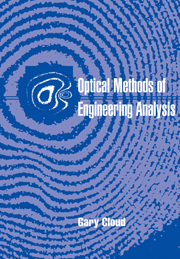Book contents
- Frontmatter
- Contents
- Acknowledgments
- 1 Introduction and orientation
- Part I Optics and interferometry
- Part II Photoelasticity
- 4 Photoelasticity theory
- 5 Basic applied photoelasticity
- 6 Photoelasticity methods and applications
- Part III Geometrical moire
- Part IV Diffraction theory, optical processing, and moire
- Part V Moire interferometry
- Part VI Holographic interferometry
- Part VII Speckle methods
- Author index
- Subject index
5 - Basic applied photoelasticity
Published online by Cambridge University Press: 12 January 2010
- Frontmatter
- Contents
- Acknowledgments
- 1 Introduction and orientation
- Part I Optics and interferometry
- Part II Photoelasticity
- 4 Photoelasticity theory
- 5 Basic applied photoelasticity
- 6 Photoelasticity methods and applications
- Part III Geometrical moire
- Part IV Diffraction theory, optical processing, and moire
- Part V Moire interferometry
- Part VI Holographic interferometry
- Part VII Speckle methods
- Author index
- Subject index
Summary
Herein we describe how to set up a photoelasticity interferometer, calibrate it, manufacture models, obtain fringe patterns, and interpret them to obtain maps of stress directions and stress magnitudes. More can be said on all these topics; some are expanded in Chapter 6. Persons planning extensive experiments using photoelastic interferometry should also become familiar with the excellent treatments in the several available books and handbooks (e.g., Burger 1987; Dally and Riley 1991; Frocht 1941; Jessop and Harris 1949; Post 1989; Wolf 1961).
Polariscope optics
Many different choices of optical elements and systems are possible for conducting model analysis by photoelastic interferometry. The object here will be to describe a few practical basic arrangements for general use. Much confusion is avoided if a systematic approach is adopted. It is apparent that certain basic optical functions must be accomplished in a polariscope. As long as the basic functions are served, there is considerable latitude in the final choice of optical elements. These points are especially important when a polariscope is being built for a special research application.
The optical system can be represented in block diagram form as shown in Figure 5.1. The light source must be capable of providing fairly intense monochromatic radiation as well as white light. For most efficient operation, the radiation must be collimated. These requirements taken together mean that the lamp must be small, intense, and spectrally pure, although the last restriction may be eased if filters are used to separate monochromatic light from multicolor radiation. For most photoelastic investigations, it has proven best to use mercury vapor or sodium vapor discharge lamps.
- Type
- Chapter
- Information
- Optical Methods of Engineering Analysis , pp. 77 - 100Publisher: Cambridge University PressPrint publication year: 1995

